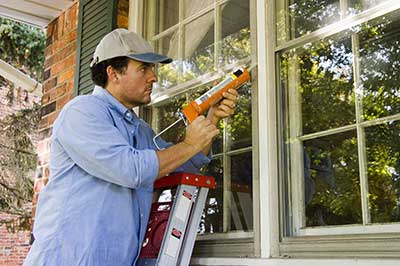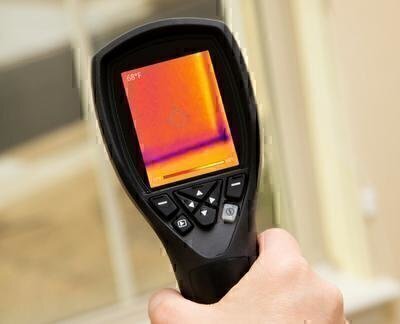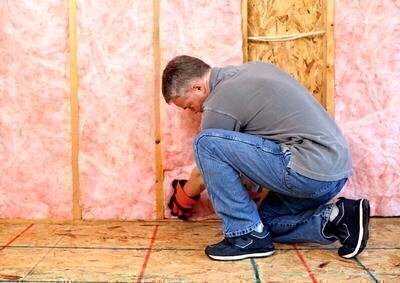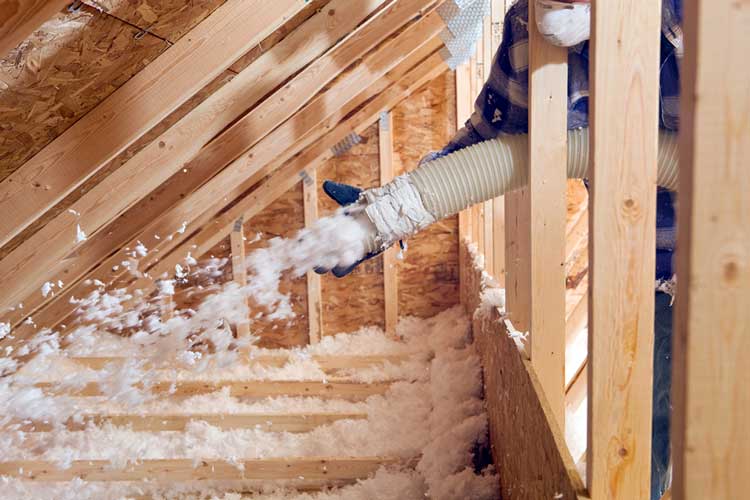Last updated February 2021
Looking for cost-effective ways to reduce your home’s energy consumption? Our section on how to save energy at home shares more than 30 changes that will cut costs—and help the planet—from cheap-yet-effective steps to upgrades that require some upfront spending, but quickly pay for themselves from lower utility bills.
Because heating is by far the biggest energy eater for Boston area homes, typically accounting for about two-thirds of utility expenses, it makes sense to focus first on cutting that consumption. For many homes, a big money-saver is to install or add insulation in spots that need it, and to seal cracks and gaps to reduce air leakage. If your home is under-insulated or has a lot of air leaks, heat escapes during winter and your hard-earned money floats away, too.
The opportunities to save are especially large for Bay State residents. Mass Save, a program offered by utilities operating in Massachusetts, is offering rebates that pay 75 percent of insulation costs and reimbursing all costs of air-sealing projects.
First, Look for Leaks
Feel drafts in the winter? That’s an obvious sign of leaks. If you consistently get cold between furnace cycles, that’s another sign.
One little leak might not seem like a big deal but having several can add up to the equivalent of leaving open a small window. It usually costs very little money to identify and fix ways your home passively wastes energy, but it yields significant savings.
To qualify for Mass Save’s rebates, you first have to contact a program-approved contractor to perform an energy audit and prepare a list of recommended improvement projects. The audit is free, and you can access a list of approved contractors at www.masssave.com or by calling 866-527-7283.
 During the audit, the inspector will identify and seal leaks. Most occur where different building materials meet—brick and wood siding, foundation and walls, and chimney and siding. Other common problem areas are around windows and doors; mail slots; points of entry for electrical and gas lines, cable/internet wiring, and phone lines; outdoor water faucets; where vents pass through walls; cracks or gaps in siding, stucco, masonry, and all foundation materials; and around window air-conditioning units.
During the audit, the inspector will identify and seal leaks. Most occur where different building materials meet—brick and wood siding, foundation and walls, and chimney and siding. Other common problem areas are around windows and doors; mail slots; points of entry for electrical and gas lines, cable/internet wiring, and phone lines; outdoor water faucets; where vents pass through walls; cracks or gaps in siding, stucco, masonry, and all foundation materials; and around window air-conditioning units.
To minimize leakage on your own, install weatherstripping around doors and windows. Open-cell foams are inexpensive and relatively inefficient but easy to apply and suitable for low-traffic areas. Vinyl is more expensive and lasts longer. Metals last for years and provide a decorative element for older homes. Also add sweeps to the bottoms of all exterior doors to seal gaps there.
Prevent drafts around outlets and light switches located inside exterior walls by adding insulating receptacle gaskets, which cost less than $5 each.
If you have window A/C units, remove them during the winter, or insulate them from the outside with an A/C cover ($20-$60). During summer, install units so they fit tightly within windows.
Together, these measures can save you five to 20 percent on heating and cooling costs.
 If you want a full energy audit, you can hire your own inspector. A comprehensive audit typically costs $400 to $600, but you’ll get a lot of info out of it. The inspector will examine all features of your residence and evaluate your utility spending for the last year. For a full audit, the company should use a calibrated blower door to measure the overall air leakage of your home and perform a thermographic inspection using an infrared camera. Confirm in advance that it will do these tasks; if not, find another company.
If you want a full energy audit, you can hire your own inspector. A comprehensive audit typically costs $400 to $600, but you’ll get a lot of info out of it. The inspector will examine all features of your residence and evaluate your utility spending for the last year. For a full audit, the company should use a calibrated blower door to measure the overall air leakage of your home and perform a thermographic inspection using an infrared camera. Confirm in advance that it will do these tasks; if not, find another company.
In our “Energy Use Consultants” section, we provide customer reviews we’ve collected from local homeowners for auditors they hired. You also may as well hire one certified by the nonprofit Residential Energy Services Network (RESNET). Certified auditors must complete RESNET’s training program and carry a minimum of $500,000 in liability insurance.
Do You Need to Add Insulation?
All structural elements enclosing your home’s living spaces should be insulated. It’s most practical to add insulation when a home is built or during renovations. Otherwise, accessibility usually drives costs and often determines what’s worth doing, but the Mass Save program offers such big incentives to homeowners—it pays for 75 percent of recommended insulation improvement costs—that most insulation projects are worth doing.
Because warm air rises, your attic is the front line in the battle to conserve energy during winter. And because most attics are unfinished and contain a lot of empty space, adding a thick layer of insulation is an easy job.
In this region, the U.S. Department of Energy (DOE) recommends attics be insulated at R-38 or better . Check what type of insulation you already have (loose fibers, granules, batts, etc.) and measure its thickness. To achieve an R-49 rating, loose fiberglass particles should be laid at a thickness of about 20 inches, rock wool particles at 17 inches, cellulose (looks like shredded newsprint) at 13 inches, and batts (blankets that come in rolls) at 15 inches.
Unheated areas underneath ground floors, such as crawlspaces and basements, are also good places to add insulation. Crawlspaces should be dry year-round (moisture causes insulation to deteriorate), and a vapor barrier should be placed on the floor of the crawlspace.
 If your home was built in the 1970s or later, its exterior walls probably have adequate insulation. If your home is older, it’s likely worthwhile to install insulation or improve what has deteriorated. To do so, installers have to drill access holes between each pair of wall studs, blow in insulation, and then patch and reseal the openings. This is much more time-consuming, messy, and costly than insulating an open unfinished attic or a crawlspace, but the rebates offered by Mass Save sharply reduce the price tag. For an average-size home in this area, adding R-11 of insulation to uninsulated exterior walls will likely save $300 to $400 in energy costs per year.
If your home was built in the 1970s or later, its exterior walls probably have adequate insulation. If your home is older, it’s likely worthwhile to install insulation or improve what has deteriorated. To do so, installers have to drill access holes between each pair of wall studs, blow in insulation, and then patch and reseal the openings. This is much more time-consuming, messy, and costly than insulating an open unfinished attic or a crawlspace, but the rebates offered by Mass Save sharply reduce the price tag. For an average-size home in this area, adding R-11 of insulation to uninsulated exterior walls will likely save $300 to $400 in energy costs per year.
Is It Worth It?
The generous rebates offered by the Mass Save program make it a no-brainer for Boston area homeowners to seal air leaks and improve attic insulation, if needed.
Since attics in most homes are easily accessed and unfinished, they’re ideal targets for improving insulation.
To add insulation to increase the rating from R-11 to R-49 in an 1,800-square-foot unfinished attic for a one-story home, Mass Save estimated for us a total job cost of $3,672. After applying Mass Save’s 75 percent rebate, the homeowner’s share of that is only $918. Using the U.S. Department of Energy’s Home Energy Saver tool, we found that such an insulation improvement for our sample home would generate utility savings of about $330 per year. That means our illustrative homeowner’s project costs, after applying the Mass Save rebate, would be recovered in less than three years from lower utility bills.
Hiring an Installer
To get Mass Save’s rebate, you’ll have to hire a company from its “approved” contractors list to do the work. The first step is to get an energy audit from one of those companies. The inspection and recommendations report it will supply are free, as is any air-sealing work it performs during the visit. You then contract with that company, or another approved contractor, if you want to pay to complete any additional recommended work.
Because the Mass Save program uses a pricing schedule for work that’s eligible for its rebate program, there’s little reason to bother shopping around. So focus on finding a company that does great work.
Get a contract that details the size of the area to be insulated, what type and how much insulation will be installed, and the resulting R-value (required by the Federal Trade Commission). For blown-in loose-fill insulation, the contract should also state the depth in inches of insulation present before new insulation is added and the depth after the work is done. If the company will be sealing cracks and other infiltration points, make sure the contract specifies the location of these areas.
If your project qualifies for Mass Save’s rebate program, confirm that you’ll qualify for the incentive. The program requires homeowners to work with its “approved” contractors and to file paperwork to get the rebate.
 Before work begins, a rep should inspect the jobsite and check for any issues—for example, to make sure there is no exposed wiring in any area before it is insulated. (Insulation cannot be installed over old knob-and-tube-style wiring.)
Before work begins, a rep should inspect the jobsite and check for any issues—for example, to make sure there is no exposed wiring in any area before it is insulated. (Insulation cannot be installed over old knob-and-tube-style wiring.)
Other matters to cover in the contract—
- In attic spaces, the contract should promise that the company will keep attic vents free of blockage. Typically, a company will use fiberglass batts to build a dam around spaces that should not be covered by insulation. In addition, be sure the company will insulate the attic’s access panel or pull-down stairway.
- Check for any recessed lighting fixtures (like can lights) that are exposed in the attic. If they are marked “IC” (insulated contact), it means insulation can contact them. If they are not IC-rated, be sure the contractor promises to keep insulation a minimum of three inches away to avoid a fire hazard.
- If ductwork, boiler pipes, or hot-water-supply pipes run through the area to be insulated, the contract should require the contractor to insulate them with R-6 insulation.
- If you will be insulating walls, the contract should specify where the company will create holes, how many, and how the openings will be closed and repaired.
- Reference in the contract a material fact sheet, which the company should attach, describing the insulation that will be installed (contractors are legally obligated to provide a fact sheet, upon request).
- Unless your job requires more than one day’s work (most don’t), don’t agree to pay until all work has been completed.
Before paying, check that all cracks were sealed as agreed upon, that the amount of insulation added matches the proposal, and that loose-fill insulation was applied evenly. Also, make sure the crew has cleaned up the area.


